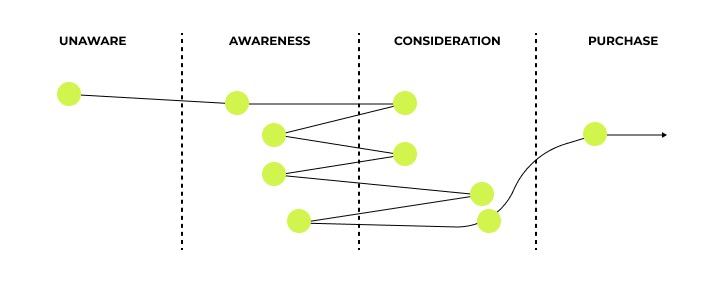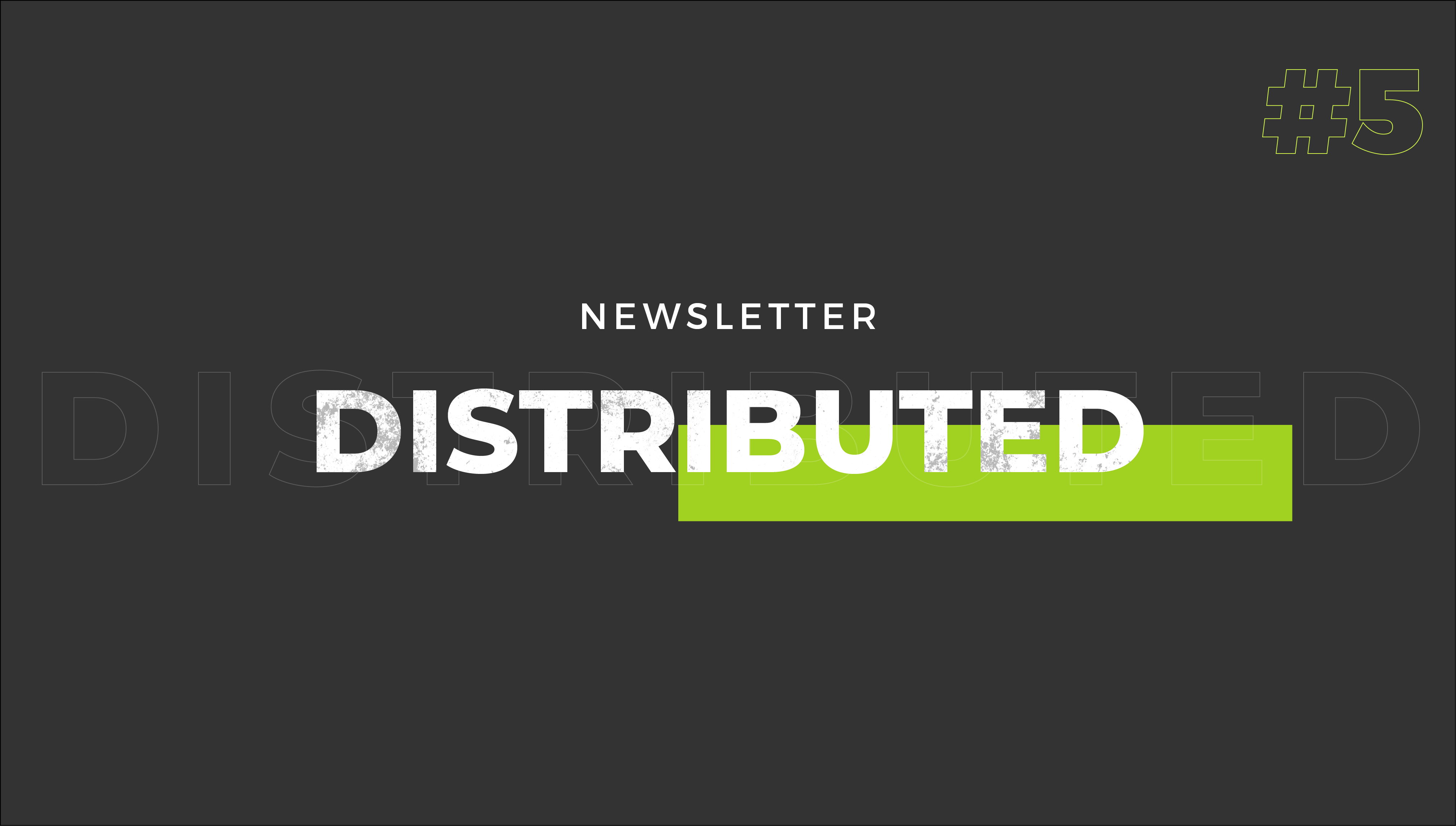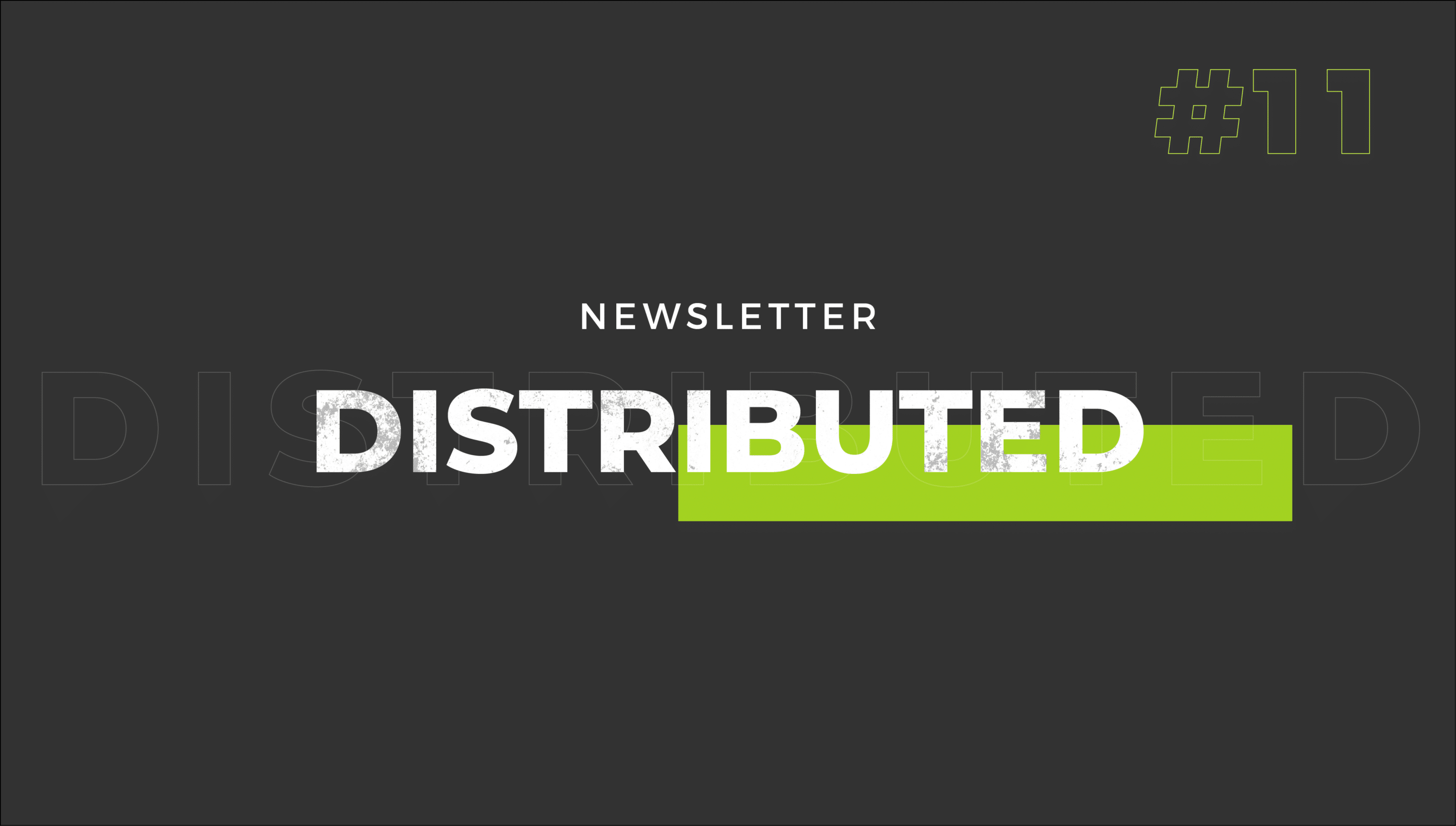As a senior leader in the world of manufacturing through a distributed sales channel, you’re familiar with the complex relationship between OEMs and dealers. When in sync, this partnership can be incredibly effective. However, misalignment can lead to inefficiencies and missed opportunities.
Marketers Think People Are Always Buying
In most marketer’s imaginations, the funnel that moves people from awareness to consideration to purchase is a linear process. We make prospects aware of our brand and then “nurture” them for weeks, months, and sometimes years to get them ready to buy. Their buyer journey looks like this:
But that’s not how most people become brand-aware. Most people get glimpses of a brand, and when they encounter it more over time via advertising or on the shelf, they cycle into and out of consideration when they’re in a buying mode. It really looks more like this:

Here’s an example: When I was buying mulch for my house this spring, I found several local dealers, visited multiple lots, read articles, and talked to neighbors. I bought a few bags from the big box store, but I need to buy a lot more this fall, and I’m not committed to the last kind I purchased. I’ve been back to the website of my favorite provider a few times. I still haven’t purchased from them, but I plan to.
To that company, I look like a lost prospect. In reality, whenever I’m reminded of how I need to put out some mulch, I re-enter the “consideration” stage. It’s taken a long time, but that cycle produces an ongoing opportunity to be their customer.
Solving this from a brand perspective requires what marketing expert Avinash Kaushik refers to as the “spike and sustain” approach in brand marketing. The goal is to maintain consistent awareness (sustain) while also having periods of increased marketing efforts (spike).
It’s in this phase that a well-tuned OEM-dealer relationship can have the most significant impact.
Navigating the Consideration Phase: OEM and Dealer Roles
The consideration phase is where the cyclical nature of the buyer’s journey becomes most apparent. Customers may enter and exit this phase multiple times before making a purchase. Both OEMs and dealers play crucial roles during this stage, but their approaches should be distinct yet complementary.
OEM Role in Consideration
OEMs should focus on providing broad, comprehensive resources that customers can return to throughout their consideration process. This includes:
- Online Configurators: Allow customers to build and price their ideal vehicle, saving configurations for future reference.
- Detailed Product Information: Provide in-depth specifications, feature explanations, and comparison tools.
- Brand Storytelling: Share the brand’s history, values, and vision to create emotional connections.
- Educational Content: Offer articles, videos, and infographics explaining new technologies or industry trends.
- Social Proof: Showcase awards, reviews, and customer testimonials to build credibility.
By maintaining a strong online presence with these resources, OEMs ensure that customers have a reliable source of information each time they re-enter the consideration phase.
Dealer Role in Consideration
Dealers have the advantage of local presence and the ability to provide hands-on experiences. Their role in the consideration phase should focus on:
- Personalized Engagement: Offer one-on-one consultations, both in-person and virtual, to address specific customer needs.
- Test Drives: Facilitate both traditional and extended test drives to give customers a real feel for the vehicle.
- Local Market Knowledge: Provide insights on how specific models perform in local conditions or meet local needs.
- Competitive Comparisons: Offer side-by-side comparisons with competitor vehicles, ideally through in-person demonstrations.
- Financing Options: Explain various financing and leasing options tailored to individual customer situations.
In our recent research, an OEM representative highlighted a key challenge: “The transition to digital has left some dealers behind in what their staff can do.” This presents an opportunity for dealers to invest in digital skills training, enabling them to blend online engagement with their traditional in-person expertise.
Traffic Direction Strategies: Maximizing Online Engagement
In the digital age, deciding where to direct online traffic — OEM websites or dealer platforms — is a critical strategic decision. The right approach can significantly impact the customer’s journey and ultimately, conversion rates.
OEM Platforms: The Brand Hub
OEM websites serve as the central hub for brand information and should be optimized for:
- Brand Storytelling: Showcase the brand’s heritage, values, and vision.
- Product Information: Provide comprehensive details on all models and trims.
- Technology Showcases: Highlight innovative features and technologies.
- Lead Capture and Scoring: Implement sophisticated systems to gather and qualify leads before distribution to dealers.
OEM sites are ideal for customers in the early stages of consideration or those re-entering the consideration phase.
Dealer Platforms: The Local Connection
Dealer websites bridge the gap between brand awareness and local action. They should focus on:
- Local Inventory: Showcase available models and trims on the lot.
- Special Offers: Highlight dealer-specific promotions or financing options.
- Service Department: Promote maintenance and repair services.
- Direct Contact Options: Provide easy ways to schedule test drives or consultations.
Dealer sites are crucial for customers nearing the end of their consideration phase, ready to take concrete steps towards a purchase.
Implementing Effective Hand-off Processes
The key to distributing contacts and leads successfully lies in creating seamless transitions between OEM and dealer systems. There are tools and processes that support consistent handoffs between groups including strong branding, smart geo-targeting for lead generation and distribution, transparent inventory systems to show locally and regionally available products , shared or connected CRM systems, and clear call-to-actions.
As one OEM stated, “We need to do things differently but in conjunction with our [dealer] network to drive more value.” This collaboration is essential in creating a unified digital experience that serves customers at every stage of their journey.
Allocating Advertising Dollars: A Strategic Approach
Given the cyclical nature of the buyer’s journey, how should OEMs and dealers allocate their advertising budgets? The answer lies in understanding the distinct roles each plays in the customer’s path to purchase.
OEM Advertising: Building the Brand
OEMs should focus on broad market awareness and brand building. Their target market is national or even global, and their goal is to create and maintain brand presence in the minds of potential customers. This aligns with the “sustain” part of Kaushik’s “spike and sustain” strategy.
OEM advertising should:
- Create emotional connections with the brand
- Highlight unique selling propositions of the brand and its models
- Educate consumers about new technologies or features
- Maintain presence during extended consideration periods
For example, an OEM might run a national TV campaign showcasing its commitment to sustainability across its entire line-up. This keeps the brand top-of-mind for environmentally conscious consumers, even if they’re not currently in the market for a new vehicle.
Dealer Advertising: Driving Local Action
Dealers, on the other hand, should concentrate on local, conversion-focused activities. Their market is defined by specific geographical areas, and their advertising should aim to turn brand awareness into tangible actions.
Dealer advertising should:
- Promote local inventory and special offers
- Highlight dealership-specific services or amenities
- Drive traffic to the dealership for test drives or events
- Create a sense of urgency for local buyers
A dealer might, for instance, run targeted social media ads promoting a weekend sales event, complete with special financing offers on specific models that are overstocked.
Layering OEM and Dealer Efforts
The real magic happens when OEM and dealer efforts are strategically layered. OEM awareness campaigns should smoothly transition into dealer conversion efforts. This might look like an OEM’s national campaign for a new SUV model being followed up by dealer ads showcasing local availability and test drive opportunities.
This layering requires clear communication and coordination. As one dealer noted, “Pricing programs are far too extensive and convoluted. We had to hire a [Finance and Insurance] specialist to make sure we weren’t leaving money on the table.” This highlights the need for OEMs to simplify and clarify their programs to ensure dealers can effectively implement them at the local level.
By carefully considering these strategies for navigating the consideration phase, directing traffic, and allocating ad dollars, OEMs and dealers can create a powerful, unified approach to channel marketing. This alignment not only improves efficiency but also enhances the customer experience, ultimately driving both brand loyalty and sales.






